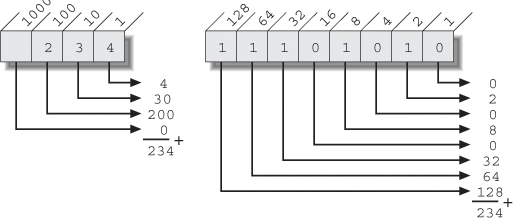Appendix B. Binary Logic, Netmasks, and Prefixes
A good understanding of netmasks and prefixes is essential when managing networks using VLSM and CIDR. For this purpose, we must look at IP addresses and netmasks the same way routers do: in binary format. This isn’t as complicated as it sounds; binary representation is not very different from our regular decimal numbers; it just uses a smaller set of digits. There are only two values that can be expressed by a single binary digit (“bit” for short): 0 and 1. This may seem like a huge limitation, but it’s not so bad; after all, our regular digits only have room for the values 0 to 9. For larger numbers, we have to use two or more of them. In binary, we just start using double digits sooner: at two rather than at ten. Table B-1 shows how this works out when counting in both decimal and binary.
Decimal | Binary |
0 | 0 |
1 | 1 |
2 | 10 |
3 | 11 |
4 | 100 |
5 | 101 |
6 | 110 |
7 | 111 |
8 | 1000 |
9 | 1001 |
10 | 1010 |
11 | 1011 |
12 | 1100 |
The basic method of expressing numbers is the same in binary as in decimal: the value of a digit in a multidigit number depends on its place relative to the other digits. This isn’t the only imaginable way to express numeric values; for instance, Roman numerals use a different mechanism. Figure B-1 illustrates the similarities between decimal and binary.

The decimal value 234 has three ...
Get BGP now with the O’Reilly learning platform.
O’Reilly members experience books, live events, courses curated by job role, and more from O’Reilly and nearly 200 top publishers.

